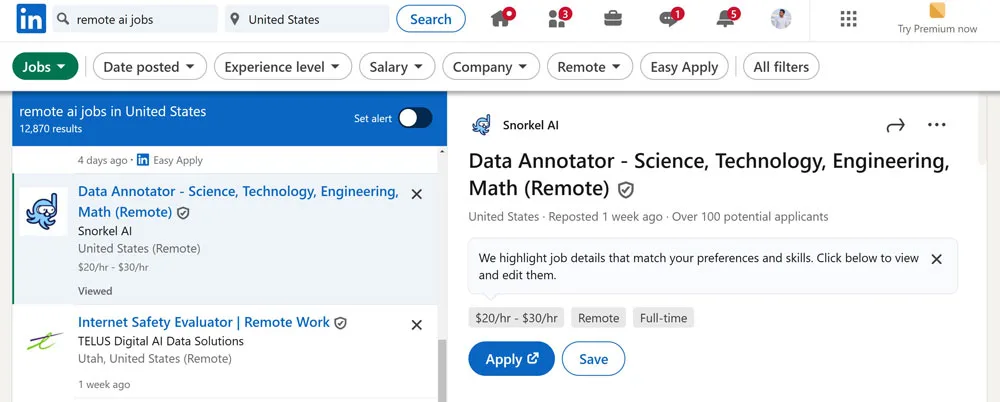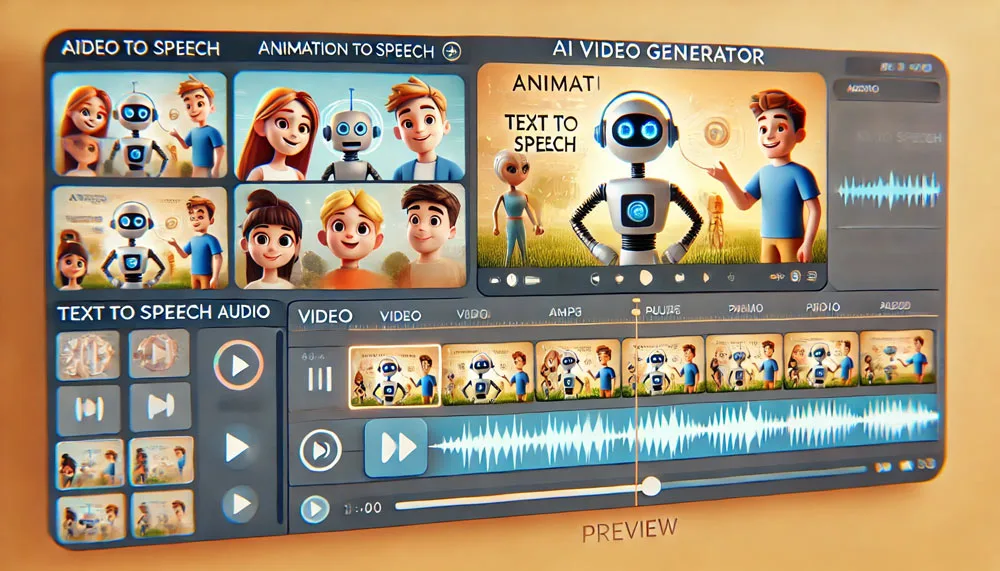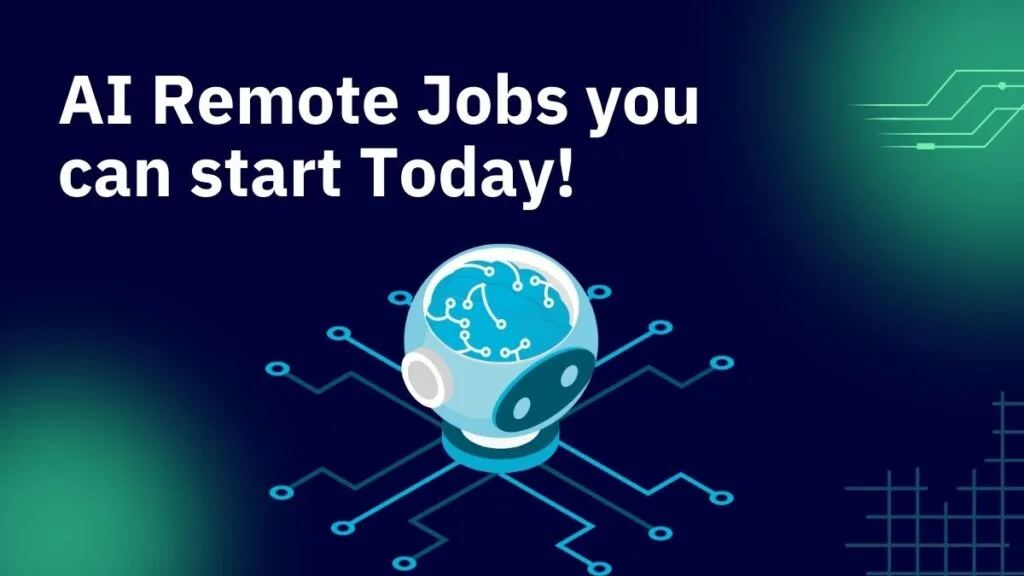You can start a remote AI job today if you have the right skills. As companies across industries harness the power of AI, they’re not just looking for programmers and tech experts. Right now, there are plenty of jobs available, from AI artists to AI developers. The market for artificial intelligence is projected to grow beyond $243 billion by 2025, marking a substantial increase of nearly $59 billion compared to 2024.
With remote AI jobs still relatively new, there’s currently a skill shortage. Some of these roles require programming and machine learning expertise, while others demand little to no technical or programming background. In this article, I’ll break down different categories of remote AI jobs you can pursue, whether you have programming skills or not.
Table of Contents
Remote AI Jobs You Can Start Without Programming Skills
In this section, we’ll explore AI-related roles that don’t demand technical expertise, making them perfect for individuals who want to break into the field without a coding background.
1. AI Data Labeling and Annotation
Data labeling is a fundamental process in machine learning that involves categorizing data for model training. In this role, you might label images, videos, or text to teach AI systems to recognize patterns, such as tagging objects in images. Ideal for people with an eye for detail and organization, data labeling jobs don’t require a coding background, making them accessible to those new to AI. The demand for labeled data in fields like healthcare, retail, and automotive industries is growing rapidly, providing many opportunities for remote workers.
Skill Needed: Attention to detail, patience, and strong organizational skills. This role does not require programming knowledge, making it accessible to entry-level professionals.

2. AI Chatbot and Virtual Assistant Trainer
As chatbots and virtual assistants become essential to customer service, companies need trainers to refine these systems. This role involves creating natural, accurate conversation flows to help chatbots respond effectively to a wide range of customer queries. Ideal for individuals with strong communication and problem-solving skills, AI trainers curate scenarios to improve AI responses without needing technical expertise. Many companies, especially those in retail and customer support, seek professionals to guide their chatbots for a more personalized customer experience.
Skill Needed: Strong communication skills, problem-solving, and an understanding of customer service dynamics. No technical expertise is required, but familiarity with conversational interfaces can be beneficial.
3. AI Artists
The role of an AI artist involves using AI-powered tools to create digital artwork, illustrations, or other visual content without the need for programming skills. AI artists leverage platforms like Midjourney, DALL-E, or Stable Diffusion to bring creative concepts to life. They experiment with prompts, adjust parameters, and curate the AI-generated output to match their vision, making it a great role for individuals with a creative background or an interest in digital art.
Skill Needed: A strong sense of creativity, familiarity with AI art tools, and an understanding of design aesthetics. No technical knowledge or programming skills are necessary, though experience in digital art or graphic design can be advantageous.
Here are few AI Art Subniche Roles you can choose from:
| Role Name | Description |
|---|---|
| AI Avatar Design | Creates customized digital avatars for clients, social media, and virtual environments, adjusting style, appearance, and expressions to match specific needs. |
| ComfyUI Workflow Creation | Designs user-friendly workflows within ComfyUI, helping users streamline AI tasks like data entry or content generation. |
| AI Image Editing | Uses AI-powered editing tools to enhance or transform images, performing tasks such as background removal, color adjustments, or style transfers. |
| Midjourney Artists | Generates unique digital art using the Midjourney platform by experimenting with text prompts and styles for commercial or personal projects. |
| Stable Diffusion Artists | Produces high-quality digital images on Stable Diffusion based on descriptive prompts, exploring various styles and themes for client or personal use. |
4. AI Content Writing
AI content writing involves using AI-powered tools to create written content for blogs, social media, websites, and more. In this role, you work with AI software to generate ideas, drafts, and polished content pieces, helping brands produce engaging material quickly. It’s an ideal role for creative professionals who can guide AI outputs to align with brand tone and messaging. Here are a few sub-niches you can explore:
- Custom Writing Prompts: This involves engineering custom prompts for AI tools like ChatGPT, Claude, and Gemini.
- AI Content Editing: Here, you refine AI-generated content, giving it a human touch through editing and polishing.
Skill Needed: Strong writing and editing skills, creativity, and an understanding of content trends. Familiarity with AI writing tools like ChatGPT, Jasper, or Copy.ai is beneficial, though no programming knowledge is required.
5. AI Video Generation
AI video generation involves using AI-powered tools to create and edit video content for platforms such as YouTube, social media, and websites. In this role, you work with AI software to develop video concepts, create animated sequences, and enhance footage with AI-driven effects. This is an excellent position for creative professionals who want to produce engaging video content without traditional editing software. Here are a few sub-niches you can explore:
- AI-Generated Avatars: Develop AI-generated avatars and characters for video content, enhancing personalization and engagement.
- AI Music Videos: Generate music videos using AI, creating visual effects and animations that align with the rhythm and tone of the music.
- AI Video Art: Experiment with AI-generated visuals and effects to create unique, artistic video content that pushes creative boundaries.
Skill Needed: Creativity, a good eye for visual storytelling, and familiarity with AI video tools like Synthesia, Pictory, or Runway ML. No programming knowledge is required, but experience in video editing or animation can be helpful.

6. AI Audio
AI audio generation involves using AI tools to create, edit, and enhance audio content for various platforms, including podcasts, video soundtracks, audiobooks, and more. In this role, you work with AI software to generate realistic voices, add sound effects, and produce high-quality audio without needing a recording studio. This position is well-suited for creative individuals interested in bringing sound projects to life using innovative AI tools. Here are a few sub-niches you can explore:
- Voice Synthesis & AI: Use AI to synthesize lifelike voices for characters, narration, or brand voices, enabling dynamic, personalized audio experiences.
- Text to Speech: Convert written content into spoken audio, creating accessible and engaging content for users, with options for different tones, accents, and languages.
Skill Needed: Strong audio production sensibilities, creativity, and familiarity with AI audio tools like Descript, Murf, or Resemble AI. No programming knowledge is required, though experience in audio editing or sound design can be advantageous.
7. AI Marketing Strategist
An AI marketing strategist leverages data insights provided by AI tools to design and refine campaigns, which makes it an attractive role for those with a background in marketing. The role involves analyzing audience behavior, customizing content, and adjusting campaigns based on AI-generated insights. This job doesn’t require technical knowledge, but it does require skills in digital marketing, trend analysis, and content personalization. Many tech companies and startups look for AI-savvy marketing strategists to stay ahead in their outreach and engagement.
Skill Needed: Strong skills in digital marketing, trend analysis, and data interpretation. Knowledge of AI-based marketing tools like HubSpot or Salesforce is beneficial, but programming knowledge is not required.
AI Remote Jobs That Require Programming or Technical Knowledge
These positions are suitable for those with a background in programming, data science, or machine learning, requiring a deeper understanding of AI and technical skills.
1. AI Developer (Chatbots, Virtual Assistants, Fine-Tuning)
AI developers work on creating, integrating, and optimizing AI applications across various platforms. This role involves developing intelligent systems that can perform tasks such as natural language processing, image recognition, or predictive analytics. AI developers are key in building and customizing AI solutions for businesses, enhancing user experiences, and automating complex processes. Here are some sub-niches within AI development:
| Sub-niche | Description |
|---|---|
| AI Applications | Develop specialized AI applications tailored to business needs, such as recommendation engines, image classifiers, and speech recognition tools. |
| AI Integrations | Integrate AI features into existing software or systems to enhance products with smart, data-driven functionalities. |
| AI Chatbot | Create conversational AI systems, like chatbots, that interact naturally with users, providing customer support, recommendations, and more. |
| AI Agents | Design autonomous AI agents capable of performing tasks or making decisions based on specific inputs, improving efficiency in customer service and operations. |
| AI Fine-Tuning | Fine-tune pre-trained AI models to meet specific industry requirements or improve accuracy for targeted tasks, adapting them for specialized use cases. |
| OpenAI GPT Store | Develop and deploy applications on the OpenAI GPT Store, utilizing GPT models for content creation, customer engagement, data analysis, and other use cases. |
Skill Needed: Proficiency in programming languages like Python or JavaScript, familiarity with AI frameworks (TensorFlow, PyTorch), and experience in natural language processing and machine learning. A background in computer science or software development is essential.
2. Data and Machine Learning
Data and machine learning roles focus on analyzing, interpreting, and leveraging data to support decision-making and automate processes. Professionals in these fields work with data to build models, generate insights, and visualize findings, driving impactful business decisions. They play a crucial role in implementing machine learning algorithms that enable predictive analytics and data-driven applications. Here are some key sub-niches:
| Sub-niche | Description |
|---|---|
| Data Science | Data scientists analyze large datasets to uncover trends, patterns, and insights that inform strategic business decisions. They design models, use statistical methods, and interpret data to solve complex problems across various industries. |
| Data Analytics | Data analysts process and analyze data to generate actionable insights, often using descriptive statistics and data transformation techniques. They support business intelligence efforts, helping companies understand trends and improve performance. |
| Data Visualization | Data visualization specialists create charts, graphs, and other visual representations of data to make complex information easier to understand. They work closely with data scientists and analysts to turn data into visually engaging, meaningful insights. |
| ML Models | Machine learning specialists build, test, and deploy machine learning models to automate tasks, make predictions, and improve efficiencies. They work with algorithms and data to create intelligent systems that can learn and adapt over time. |
Skill Needed: Proficiency in programming languages like Python or R, experience with data analysis and visualization tools (Pandas, Tableau, Matplotlib), and strong analytical skills. Familiarity with machine learning frameworks (TensorFlow, scikit-learn) and a background in statistics or mathematics are also beneficial.
3. Computer Vision Engineer
Computer vision engineers develop AI systems that process and analyze visual data, such as images and videos, enabling machines to “see” and understand visual information. This role involves building models for object recognition, image classification, and video analysis, applying computer vision techniques to solve real-world problems. Computer vision engineers work in various fields, including healthcare (for medical imaging), retail (for automated checkout), and security (for surveillance systems), where visual data processing is essential. Here are some key sub-niches within computer vision engineering:
- Image Recognition: Design and train models to recognize and classify objects in images, commonly used in applications like facial recognition and autonomous vehicles.
- Video Analysis: Develop systems that can process video data to detect actions, track objects, and interpret movement patterns for purposes like surveillance, sports analysis, or traffic monitoring.
- 3D Vision and Reconstruction: Create models that generate 3D representations of objects or environments from 2D images, useful in fields like robotics, virtual reality, and industrial automation.
Skill Needed: Strong programming skills in Python or C++, experience with computer vision libraries like OpenCV and TensorFlow, and a solid understanding of image processing and machine learning algorithms. A background in mathematics or a related field, along with knowledge of deep learning frameworks, is also beneficial.
Finally, There are several AI-related jobs that can be done remotely, offering exciting opportunities in a rapidly growing field. With a range of skill levels and backgrounds required, these positions are accessible to many professionals looking to enter the AI industry. Now is a great time to get started before the market becomes more competitive. The key is to identify a niche that aligns with your strengths and interests, allowing you to excel and build a fulfilling career in this evolving field.



